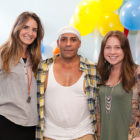
How Going to Jail Changed My Life Path, Part 2
|
Three years have passed since I first went to jail. I often think back to the bumpy, almost dangerous, ride over the bridge to Rikers Island.
Juvenile Justice Information Exchange (https://jjie.org/tag/rikers-island/page/2/)

Three years have passed since I first went to jail. I often think back to the bumpy, almost dangerous, ride over the bridge to Rikers Island.

The first time I went to jail, my professor sent me there. Before I could think too much about what I had agreed to do, I piled into a beat-up 12-passenger van with 11 others.

Every day an estimated 1,500 family members and friends of those incarcerated on New York’s Rikers Island visit their loved ones. For several months, photographer Salvador Espinoza rode the bus back and forth, documenting the stories of these people.
“It’s something we can’t sustain because it’s just this revolving door — you’re breeding kids from a young age to go into the system. I just want people to be more aware of this.”

Sometimes it seems there is an inherent conflict of interest between those who work in the field of juvenile justice and their goal of reducing youth involvement with the system. Providing a quality program that reduces recidivism, lessens the length of detention, or lowers the overall number of incarcerated youths can, in the long run, lead to the closing of facilities, shrinking allocations, and fewer jobs. Success can lead to obsolescence. There seems to be a built-in reverse incentive structure, where success never goes unpunished. This is not to say there aren’t a lot of good people doing this work, people who are dedicated to working toward something positive, and a lot of innovative strategies have been developed that seem to be working.